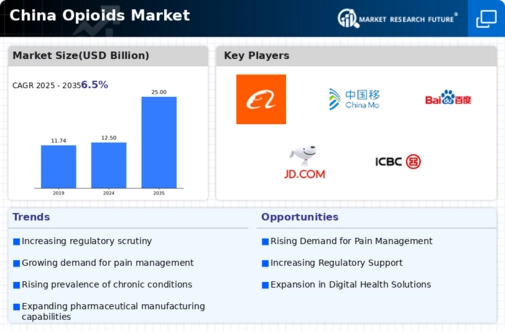Rising Pain Management Needs
The increasing prevalence of chronic pain conditions in China is driving demand within the opioids market. Conditions such as arthritis, cancer, and neuropathic pain are becoming more common, necessitating effective pain management solutions. According to recent estimates, approximately 20% of the Chinese population suffers from chronic pain, which underscores the urgent need for effective treatment options. As healthcare providers seek to address these needs, the opioids market is likely to experience growth. Furthermore, the aging population in China, projected to reach 487 million by 2050, is expected to exacerbate the demand for pain management therapies, including opioids. This demographic shift indicates a sustained and potentially increasing market for opioids as a critical component of pain management strategies.
Evolving Regulatory Landscape
The regulatory environment surrounding the opioids market in China is evolving, which may influence market dynamics. Recent initiatives aimed at balancing pain management needs with the risks of addiction and misuse are being implemented. The Chinese government has introduced stricter regulations on opioid prescriptions, which could lead to a more controlled and responsible use of these medications. While this may initially restrict access, it could also foster a more sustainable market in the long run. The focus on developing guidelines for safe prescribing practices may enhance the credibility of the opioids market, potentially leading to increased acceptance among healthcare providers and patients alike.
Growing Research and Development
Investment in research and development (R&D) within the opioids market is gaining momentum in China. Pharmaceutical companies are increasingly focusing on developing new formulations and delivery methods for opioids, aiming to improve efficacy and reduce side effects. This trend is supported by government initiatives promoting innovation in the healthcare sector. As R&D efforts intensify, the introduction of novel opioid products may enhance treatment options for patients suffering from pain. Furthermore, advancements in technology, such as smart drug delivery systems, could revolutionize how opioids are administered, potentially leading to a more favorable perception of these medications within the healthcare community.
Healthcare Infrastructure Development
China's ongoing investment in healthcare infrastructure is poised to impact the opioids market positively. The government has been enhancing healthcare facilities and expanding access to medical services, particularly in rural areas. This development is likely to facilitate better pain management practices and increase the availability of opioids for patients in need. With the healthcare expenditure in China projected to reach $1 trillion by 2030, the opioids market could benefit from improved distribution channels and increased prescription rates. Enhanced training for healthcare professionals regarding pain management and opioid prescribing practices may also contribute to a more informed approach to opioid use, potentially leading to a more responsible and effective utilization of these medications.
Increased Focus on Pain Management Education
There is a growing emphasis on pain management education in China, which is likely to influence the opioids market positively. Healthcare professionals are increasingly being trained in pain management techniques, including the appropriate use of opioids. This educational push aims to equip providers with the knowledge necessary to prescribe opioids responsibly and effectively. As awareness of pain management strategies expands, patients may become more informed about their treatment options, leading to increased demand for opioids when appropriate. This trend suggests a potential shift towards a more educated approach to pain management, which could enhance the overall perception and acceptance of opioids in the healthcare landscape.

















Leave a Comment